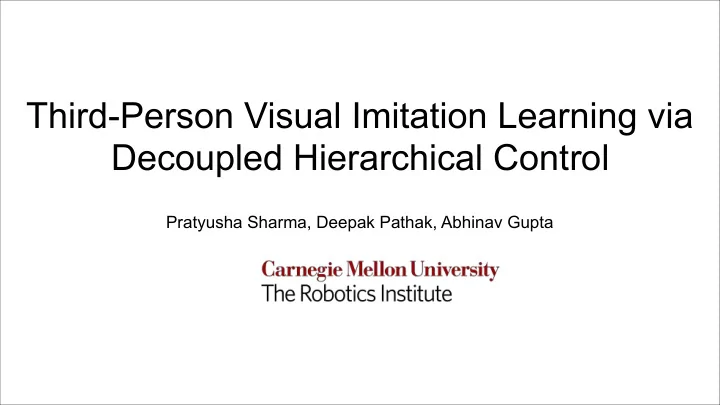

Third-Person Visual Imitation Learning via Decoupled Hierarchical Control Pratyusha Sharma, Deepak Pathak, Abhinav Gupta
Problem / Goal Can our robot manipulate a new object given a single human video alone?
Why is it hard? ● Inferring useful information in the video ● Handling domain shift ● Every major part of the sequence needs to be executed correctly - Ex: For pouring, it needs to reach the cup before twisting its hand ● The manipulation is challenging. (6D, novel objects and positioning, no force feedback)
Issue Scenario 1: Sequentially predict the states of the robot arm Output Input: Human demonstration + first image of object Issue: Not closed loop. No understanding of how the positions of the objects placed in front of the robot change with time!
Issue Scenario 2: Sequentially predict the states of the robot arm Output Input: Human Demo + Robot visual state How do we force it to use task information from Human demonstration alone but condition its action on current observable state?
We want to build a model that can infer the intent from the Human Demonstration of a task and act in the Robot’s current environment to then accomplish the task.
Approach Training Goal Generator (high-level) We decouple the task of Goal Inference from Local Control Controller (low-level) a t
Training and Test Scenarios - Data Availability Training Test (deployment) ● Human demo video ● Human demo video ● Robot demo video ● Current visible image ● Robot joint angles of the table
Approach - Training Training Goal Generator: Given human demo and Goal present visual state of Generator (high-level) the robot we hallucinate the next step
Approach - Training Training Goal Generator: Given human demo and present visual state of Goal Generator (high-level) the robot we hallucinate the next step Inverse Model : Use the hallucinated Controller prediction with the (low-level) current visual state to predict the action! a t
Train Time:The Goal Generator and Inverse Model are trained separately Test Time: The Goal Generator and Inverse Model are executed alternatingly
Approach - Test
Approach - Train Vs Test
Experiments and Results We evaluate the models trained as follows: ● Goal generation model with a perfect inverse model ● Inverse model with a perfect goal generation model ● Goal generation model and inverse model in tandem
Results: Goal generation model with perfect inverse model
Results: Inverse model with perfect goal generator GT trajectory Predicted trajectory from GT-images
Results: Final experiment runs
Results: Final Experimental Runs : Placing in a box
Shortcomings: 1. Robot trajectory is shaky: The robot trajectory looks shaky because of the absence of any temporal knowledge. Though trajectories predicted by inverse models with memory units(LSTM) look far less shaky but the models then over fit to the task
Thank you!
Recommend
More recommend